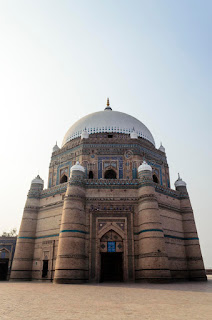Shah-e-Alam is born on 17 Dhuak Qidah 817 Hijri/18 January 1415 AD at Patan City in Gujarat, India.He is A muslim religious techer and great Wali, residing in Ahmedabad, Gujarat, India during the Mughal era.
LIfe of Shah-e-Alam
Syed Sirajuddin Muhammad, the
son and successor of Syed Burhanuddin Qutub-e-Alam, Came to be called by the title of Shah-e-Alam, ruler of the world. His dad Sheik Burhanuddin,otherwise Called Qutub-e-Alam, was the grandson of syed Makhddom jehaniya jehan Gasht. He showed up in Gujarat during the start of the
fifteenth century rule of Ahmed Shah 1, Choosing the edges of Ahmedabad of Gujarat.
Following the suharwadi custom, the family settled close contact with the Gujarat Sultanate and later with Mughal rulers and assumed a functioning part in the social and political existence of the city.
Shah-e-Alam, the 11th among twelve children, helped his dad, Qutub-e-Alam. A fascinating Marvel happened one day; while washing in a water body, his feet hit after something. The Shaikh Commented that he didn't know whether the article was stone, iron or wood. Marvelosly, the article transformed into a combination of the three materials and turned into an adored relic.
Shah Alam was identified with imperial places of sindh and Gujarat through union with bibi marqi, the second girl of jam saheb of sindh.
He went through six days every week in singular contemplation
and got guests just on Fridays, when open conversations were held. A record of
the Friday get-togethers was arranged in a seven volume manual named,
'Kunuz-e-Muhammadi' by Shaykh Farid receptacle Daulat Shah Jilwani. The record
isn't recognizable today.
He passed on 20 Jumada al akhira 880 Hijri/1475 AD. The tomb
was worked by Taj Kham Narpali and presently known as Shah-e-Alam's Roza.
Shah-e-Alam's Tomb
and Mosque, otherwise called Rasulabad Dargah or Shah Alam no Rozo, is an
archaic mosque and burial place complex (Roza) in Shah Alam space of Ahmedabad,
India.
History
Shah e Alam was the child of Hazrath Syed Burhanuddin
Qutub-ul-Alam and the extraordinary grandson of Hazrat Syed Makhdoom Jahaniyan
Jahangasht. Drawn to the court of Ahmed Shah 1, his dad settled at Vatva and
kicked the bucket there in 1452. Shah e Alam succeeded his dad and, till his
passing in 1475, was the aide of Mahmud Begada 's youth, and a short time later
one of the most venerated of Muslim strict instructors of Ahmedabad.

A gathering of structures, a burial place, a mosque, and a
get together corridor, encased by a grand and bastioned divider, was raised in
the consecrated to the memory of Shah e Alam. From the north the nook is
entered through two attractive stone passages. Inside the second door on the
left is a gathering lobby worked by Sultan Muzaffar Shah III. (1561–1572), and
halfway annihilated by the British in 1779 to outfit materials for the attack
of the city during the First Anglo-Maratha War. On the right are some different
structures of which the date has not been followed. Before these structures, to
the right is a supply, and to the left of the repository in the focal point of
the nook, is Shah e Alam's burial chamber. This, the most established of the
structures, is said to have been built before long the holy person's passing in
1475 (880AH) and finished in 1483 (888AH) by Taj Khan Nariali, an aristocrat of
Mahmud Begada's court.It is of exceptionally satisfying plan and has a
significant part of the unique person of the structures of that time. Right off
the bat in the seventeenth century Asaf Khan, the sibling of Nur Jahan,
ornamented the arch with gold and valuable stones. The burial chamber of Shah e
Alam is arranged generally in the focal point of the east finish of roza. The
burial chamber is on a square arrangement with 12 columns and a high arch in
the focal point of the rooftop, encircled by twofold passageways with 24 little
vaults on top. It has curve formed entry on all sides. The fundamental entry on
the west having a little arch ventures out from the divider. On each mass of
the tomb, there is an entry in the middle. On one or the other side of the
entry, there are three curve molded windows, over which a curve formed part
covered by punctured stone windows. The floor of the burial chamber is
decorated with high contrast marble, the entryways are of open cut metal work,
and the edge wherein the entryways aro set, just as what shews between the door
jamb and the two stone columns to the right and left, is of unadulterated white
marble perfectly cut and punctured. The burial place itself is totally encased
by an inward mass of penetrated stone. The external divider in the north is of
stone lattice work of the most fluctuated design.

West of the burial place is the mosque, worked
by Muhammad Salah Badakhshi, with minarets at either end started by Nizabat
Khan and wrapped up by Saif Khan in 1620. The mosque however satisfying in
diagram and with skilfully built vaults has a significant part of the standard
Islamic engineering found in different pieces of India, and hardly has a place
with the unique Ahmedabad style. Toward the south of the mosque, a burial place
on an arrangement like that of the main catacomb having 24 little vaults, is
the covering of Shah e Alam's family including Saiyyd Makhdum Alam, the 6th
grandson of Shah e Alam. Outside of the divider toward the west is an argo
supply worked by the spouse of Taj Khan Nariali. The minarets of the mosque
were harmed by the 1819 Rann of kutch tremor however were reestablished in
1863.
Address
Shah-E-Alam Roja, Ahmedabad, Gujarat 380028, India




